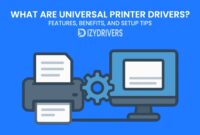Think about the last time you had to print a final report for school or an important work document just minutes before a deadline. The functions of printer in computer decided whether that task was smooth and stress-free—or a complete disaster. From basic text printing to wireless commands and high-quality photo output, printers quietly handle a lot more than we give them credit for.
In this guide, we’ll uncover these roles step by step—looking at how printers work, why each function matters, and how different printer types fit different needs. By the end, you’ll see printers not as dull office machines but as essential tools that bridge the gap between the digital world and the physical page in your hands.
What is a Printer in Computer?
Before diving deeper into the key functions of printer in computer, it helps to start with the basics. A printer is a hardware device that converts digital information from a computer into physical form—typically on paper. This process might seem straightforward, but it involves a series of precise actions: receiving data, processing commands, and producing output in the form of text, graphics, or images.
Printers have evolved tremendously since their early days. From bulky dot-matrix printers to today’s sleek, wireless all-in-one devices, the technology behind them has changed the way we handle information. Understanding what a printer is and how it integrates with computers gives you the foundation to appreciate its many functions.
Definition and Basic Concept
At its core, a printer is a peripheral device, meaning it connects to a computer to perform a specific function: producing tangible output from digital data. When you send a document to print, your computer communicates with the printer using a set of instructions called printer drivers. These instructions ensure that what appears on your screen looks exactly the same on paper.
The functions of printer in computer go beyond simply “printing.” Modern printers are capable of scanning, copying, and even faxing documents—all in one compact device. For homes and offices, this versatility makes printers an indispensable part of everyday technology.
Brief History of Printers
To better understand the functions of printer in computer, it’s helpful to look back at how printers started. The earliest printers, like the dot-matrix, used tiny pins striking against an ink ribbon to form characters on paper. They were noisy, slow, and primarily text-based.
As technology advanced, inkjet and laser printers emerged, offering higher print quality, faster speeds, and more reliable performance. Today, we even have wireless and cloud-enabled printers, making it possible to print documents from anywhere in the world. This evolution reflects how printers have adapted to meet changing user needs.
Why Printers Are Still Relevant in the Digital Era
Some people wonder if printers are becoming obsolete in a paperless world. The truth is, despite the rise of digital communication, printers remain essential in many industries. Legal documents, academic papers, architectural blueprints, and even product packaging rely on the functions of printer in computer for accuracy and convenience.
Printers also serve personal needs. Whether it’s printing family photos or craft projects, they help bring digital memories and ideas into the physical world. As long as there’s a need for tangible records and creative outputs, printers will continue to play a vital role.
Main Functions of Printer in Computer
Now that we understand what printers are and how they fit into modern computing, let’s explore the main functions of printer in computer in detail. Printers today are no longer single-purpose machines. Instead, they perform multiple tasks that support both personal and professional needs.
The table below summarizes the core functions of printer in computer before we break them down one by one:
Core Functions of Printer in Computer
| Printer Function | Description | Typical Use Case |
|---|---|---|
| Document & Image Printing | Converts digital files into physical copies on paper or other materials | Office reports, school assignments, photos |
| Scanning Capabilities | Converts physical documents into digital formats | Archiving records, sharing soft copies |
| Copying Functions | Produces duplicates of physical documents | Quick reproduction without a computer |
| Faxing Features | Sends scanned documents over telephone lines | Business communication, legal paperwork |
| Wireless Printing | Allows printing via Wi-Fi, Bluetooth, or cloud services | Remote work, mobile device printing |
| High-Resolution Output | Produces sharp, professional-quality documents or images | Marketing materials, photography prints |
This table gives a quick overview, but each function deserves a closer look. Let’s go deeper into how these features work and why they matter.
Printing Documents and Images
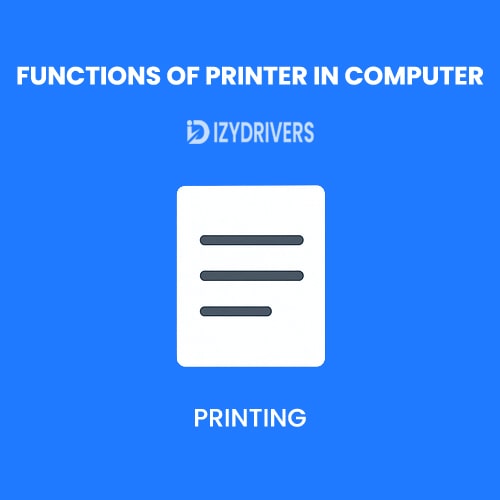
The most basic yet essential function of printer in computer is producing hard copies of documents, spreadsheets, images, or any digital content. When you hit the print command, the computer processes the file, converts it into a printer-friendly language, and sends it to the printer for output.
Modern printers offer various print settings—black-and-white, color, draft mode, or high-quality mode—depending on the user’s needs. For instance, a student printing lecture notes may prefer fast, low-ink printing, while a photographer preparing a portfolio might require maximum resolution and color accuracy.
Scanning and Copying Capabilities
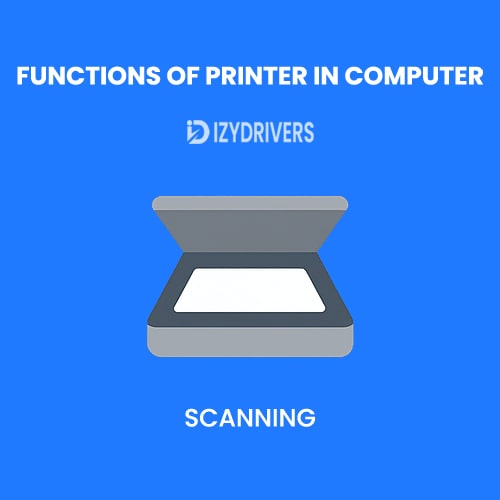
Many printers today are part of the all-in-one category, meaning they combine printing, scanning, and copying in a single device. The functions of printer in computer now include the ability to digitize physical documents through scanning, making it easy to store or email files without extra equipment.
Copying, on the other hand, saves time by creating duplicates directly from the printer without even turning on the computer. This is especially useful in offices where quick document reproduction is part of printer daily workflow.
Faxing and Wireless Printing Features
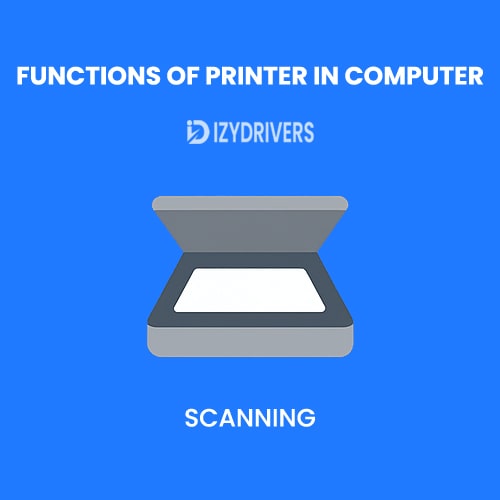
While faxing might sound outdated, it’s still widely used in industries like law, healthcare, and finance where signed documents must be transmitted securely. Many modern printers integrate fax capabilities, ensuring businesses can handle both traditional and digital document transmission seamlessly.
Wireless printing, on the other hand, is a game-changer. By connecting printers to Wi-Fi, Bluetooth, or cloud services, users can print directly from smartphones, tablets, or laptops without worrying about tangled cables or being in the same room as the printer.
High-Resolution Printing for Professional Use
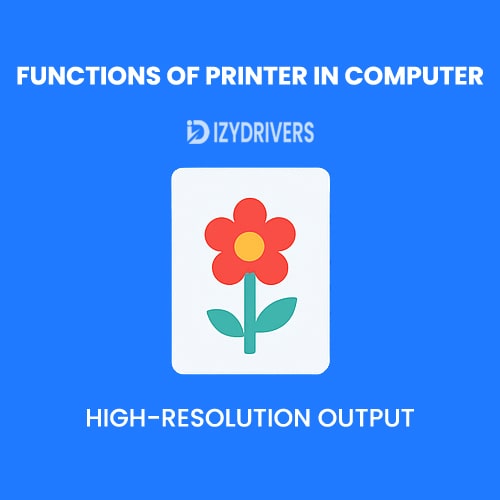
For professionals like graphic designers, architects, or photographers, print quality is critical. The functions of printer in computer include options for high-resolution output, often exceeding 1200 dpi (dots per inch). This ensures crisp text, vibrant colors, and sharp images suitable for presentations, marketing materials, or artistic projects.
Some printers also support specialty media like cardstock, labels, or even fabric, giving creative users more flexibility in their work.
Types of Printers and Their Functions
Now that we’ve explored the core functions of printer in computer, it’s important to understand that not all printers are built the same way. Different printers serve different purposes, and choosing the right one often depends on the type of work you do, the volume of printing required, and the quality expectations.
The table below highlights the most common printer types and the primary functions each offers:
Different Types of Printers and Their Key Functions in Computers
| Printer Type | Key Features | Best For | Example Functions |
|---|---|---|---|
| Inkjet Printers | High-quality color printing, affordable | Home users, students, photographers | Printing documents, photos, marketing materials |
| Laser Printers | Fast printing, cost-effective for volume | Offices, businesses | Bulk document printing, text-heavy files |
| Dot Matrix Printers | Impact printing, low cost per page | Industrial environments, receipts | Continuous form printing, multi-copy forms |
| Thermal Printers | Heat-based printing, no ink needed | Retail, shipping | Printing receipts, labels, barcodes |
| Multifunction Printers | Printing, scanning, copying, faxing | Home offices, businesses | All-in-one document handling |
Let’s break down each type in more detail so you can understand how they align with different functions of printer in computer.
Inkjet Printers
Inkjet printers are known for their ability to produce high-quality prints with vibrant colors and sharp detail. They work by spraying tiny droplets of liquid ink directly onto the paper, resulting in rich images and smooth gradients.
For users who need to print school assignments, presentations, or even photographs, inkjet printers offer flexibility at a relatively low upfront cost. However, the ink cartridges can be expensive, and frequent users may find the long-term costs higher compared to other printer types.
Laser Printers
When speed and efficiency matter, laser printers shine. These printers use toner powder and a laser beam to create precise images on paper. The functions of printer in computer in office settings often depend on laser printers because they can handle high-volume printing at a lower cost per page.
Businesses typically prefer laser printers for text-heavy documents such as reports, contracts, and invoices. While they may have a higher initial price, the cost savings on toner and paper over time make them an economical choice for many organizations.
Dot Matrix Printers
Dot matrix printers may seem like a relic of the past, but they still serve specific niches. They use tiny pins striking against an ink ribbon to create characters on paper, making them ideal for multi-copy forms and continuous printing tasks.
Industries such as logistics and manufacturing still rely on dot matrix printers for shipping labels, receipts, and carbon-copy documents. The functions of printer in computer in these environments often focus more on reliability and low operational cost than on print quality.
Thermal Printers
Thermal printers use heat-sensitive paper and require no ink or toner, making them cost-effective and low-maintenance. They are widely used in retail stores, restaurants, and shipping companies for printing receipts, barcodes, and labels.
Because thermal printers don’t rely on traditional ink, they’re fast, quiet, and efficient. However, their prints may fade over time, so they’re not ideal for documents that need to be archived long-term.
Multifunction Printers (MFPs)
As the name suggests, multifunction printers combine several tasks into one device—printing, scanning, copying, and faxing. For small offices or home users, this all-in-one printer solution saves both space and money while covering all the essential functions of printer in computer.
MFPs are especially convenient for remote work setups or small businesses where document handling needs vary daily. Instead of buying separate devices, users can rely on one machine for multiple tasks.
How Printer Functions in Computer Systems
After exploring the types of printers and what each one offers, it’s time to understand how these devices actually work when connected to a computer. The functions of printer in computer rely on a series of processes, from receiving digital data to producing a physical output.
Let’s break this down step by step so you can see what happens behind the scenes whenever you press the “Print” button.
Connection Methods: USB, Wi-Fi, and Network Printing
Printers can connect to computers in several ways, and the method you choose often depends on your needs. USB connections remain the most common option because they are simple, affordable, and reliable. Just plug in the cable, install the driver, and you’re ready to print.
However, for businesses and homes with multiple devices, network printing via Wi-Fi or Ethernet is far more convenient. Wireless printing eliminates the hassle of physical cables and allows laptops, smartphones, or tablets to send print commands from anywhere within the network. Cloud printing takes this one step further by enabling remote printing through internet-based services, which is especially useful for remote workers or students.
Printer Drivers and Software Support
Behind every successful print job is a printer driver—software that acts as a bridge between your computer and the printer. When you send a document to print, the driver translates the file into a language the printer can understand.
Most operating systems come with built-in drivers for common printer models, but for advanced features such as duplex printing, color calibration, or wireless setup, installing the manufacturer’s official driver is essential. Proper driver support ensures all functions of printer in computer work smoothly and deliver consistent, high-quality output.
Print Commands and Data Processing
Once the connection is established and drivers are in place, the computer sends print commands to the printer’s internal processor. This processor determines how text, images, and layouts appear on the page. The better the processor, the faster and more accurate the printing process.
High-end printers often feature dedicated memory for spooling large documents, allowing the computer to free up its resources while the printer handles the task independently. This is why some printers can continue printing even after the computer has shut down or moved on to other tasks.
Advantages of Understanding Printer Functions
Now that we’ve seen how printers connect to computers and process print jobs, let’s shift our focus to why this knowledge actually matters. Understanding the functions of printer in computer goes beyond technical curiosity—it has real-world benefits for productivity, cost management, and decision-making when choosing the right equipment.
Here’s how this understanding can make a difference:
Better Productivity in Offices and Schools
In workplaces and educational institutions, time is often the most valuable resource. When employees or students know how to use printers effectively—whether it’s adjusting settings for double-sided printing, selecting the right print quality, or troubleshooting basic errors—they can complete tasks faster and with fewer interruptions.
Consider a busy office where multiple users send print jobs to the same device. If people understand how the printer queues and processes tasks, there’s less confusion and fewer delays. The functions of printer in computer directly impact how smoothly documents move from screen to paper in such environments.
Cost Efficiency with Proper Printer Usage
Printing costs can quickly add up, especially in organizations that rely heavily on physical documentation. By understanding printer functions—such as draft mode for saving ink, duplex printing for reducing paper use, or selecting black-and-white over color when appropriate—users can significantly lower operating expenses.
Some printers also offer built-in monitoring tools that track ink or toner usage. Knowing how to access and interpret this information helps businesses plan better, avoid waste, and even negotiate more cost-effective supply contracts.
Choosing the Right Printer for Specific Needs
Not all printers are created equal. By learning the functions of printer in computer and matching them to specific needs, users can avoid overspending on unnecessary features or struggling with underpowered devices.
For example, a law firm might prioritize high-volume, text-based printing with secure document handling, making laser printers the best choice. Meanwhile, a photography studio would benefit more from a high-resolution inkjet printer that delivers superior image quality.
Future of Printing Technology
As technology advances, printers are evolving far beyond their traditional roles. The functions of printer in computer now include features that were once considered futuristic, offering more flexibility, efficiency, and even creativity to users.
Let’s explore the emerging trends shaping the future of printing technology and what they mean for businesses, schools, and everyday users.
Cloud Printing and Mobile Printing
Cloud printing allows users to send documents to a printer from anywhere in the world using internet-based services. This means a business traveler can print a contract at the office while sitting in a hotel room miles away. Similarly, students can send assignments to the library printer directly from their smartphones without needing a physical connection.
This shift toward cloud and mobile printing reflects how the functions of printer in computer are moving closer to modern digital workflows. As workplaces adopt remote and hybrid work models, having the ability to print without being tied to a single location is becoming increasingly valuable.
3D Printing as the Next Revolution
While traditional printers focus on paper and ink, 3D printing uses materials like plastic, metal, or resin to create three-dimensional objects. From medical implants to architectural models, the applications of 3D printing are expanding rapidly across industries.
This technology represents a massive leap in the functions of printer in computer because it turns digital blueprints into real-world objects. As costs drop and accessibility improves, 3D printers may soon become as common in workshops and classrooms as standard inkjet printers are today.
AI Integration in Modern Printers
Artificial intelligence is making its way into printing technology as well. Some modern printers can now analyze document layouts, recommend optimal print settings, and even predict when maintenance is needed before problems occur.
By automating these tasks, AI enhances the functions of printer in computer, helping users save time and reduce errors while also improving energy efficiency and resource management.
Conclusion
From simple text printing to advanced wireless connectivity and even 3D printing, the functions of printer in computer have come a long way. Printers today are no longer limited to producing black-and-white documents; they scan, copy, fax, and integrate seamlessly with cloud services and mobile devices.
Understanding these functions helps users choose the right printer, reduce operational costs, troubleshoot common problems, and prepare for the future of printing technology. Whether you are a student, a professional, or a business owner, knowing how printers work ensures you get the most value from your devices.
FAQ: Functions of Printer in Computer
What are the main functions of printer in computer systems?
The main functions include printing documents and images, scanning, copying, faxing, wireless printing, and high-resolution output for professional use.
Why is understanding printer functions important?
It helps users maximize productivity, minimize printing costs, and choose the right printer for their specific needs.
Which type of printer is best for home use?
Inkjet printers are usually best for home users because they offer high-quality printing for both documents and photos at an affordable price.
What common problems occur with printer functions?
Common problems include driver issues, paper jams, connectivity errors, and low-quality prints, most of which can be resolved with basic troubleshooting.
What is the future of printer technology?
Future trends include cloud and mobile printing, 3D printing for creating physical objects, and AI-powered printers for predictive maintenance and optimization.




